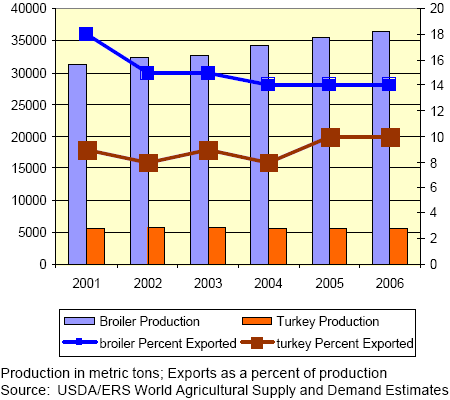



International Egg and Poultry Review
By the USDA's Agricultural Marketing Service - This is a weekly report looking at international developments concerning the poultry industry, this week looking at the EC's decision to approve regulation to reduce Salmonella in breeding chickens.
European Commission Approves Regulation to Reduce Salmonella in Breeding Chickens
The European Commission’s Standing Committee on the Food Chain
and Animal Health (SCFCAH) approved a proposal for a Commission
Regulation implementing Regulation (EC) No 2160/2003 of the
European Parliament and of the Council on the control of salmonella
and other specified food-borne zoonotic agents.
The regulation targets the reduction of the level of the five most common
salmonella serotypes in breeding flocks of chickens and sets a target
of no more than 1 percent of positive cases in breeding flocks of 250
birds or more by December 31, 2009. The Regulation allows only two
uses of microbials: to rebuild a new flock from the hatching eggs of an
infected flock, and to treat birds showing clinical signs of salmonellosis.
The regulation also restricts the use of live vaccines to control
salmonella in flocks. Vaccines should only be used if there is an effective
detection method to distinguish between salmonella from vaccines
and wild type strains of salmonella. This new Regulation has yet to be
published in the Official Journal and it is therefore hard to estimate at
this point what impact this will have. The text upon which the SCFCAH
reached an agreement does not contain specific requirements for
imports from third countries, but we expect that further steps will be
taken to address this. When the standards of this Regulation are to
apply on imports, it will possibly put extra expenses on U.S. exporters
of hatching eggs.
Source: USDA/FAS, Official Journal of the European Union, EC Health
and Consumer Protection Directorate-General, news media
U.S. Poultry Production and Exports

Organization for Economic Co-Operation and Development
Thirty OECD member countries met with Brazil, China, India and South
Africa for a high-level meeting of the OECD Committee for Agriculture in
Paris from 14 -15 June, and called for rapid progress in the multilateral
trade negotiations. The meeting underlined the need for agriculture
policy reform in order to fulfil the development dimension of the ongoing
WTO negotiations.
To this end, the participants stressed the need for
enhanced market access and reduced trade distortions due to export
competition measures and non-tariff barriers. In order for developing
countries to fully benefit from agricultural trade liberalization, well
targeted technical assistance would be required, according to the
participants.
The meeting also called for national and multilateral
assistance mechanisms to compensate potential losers and ensure
that all nations profit from the global welfare gains brought about by the
liberalization process.
Source: BRIDGES Weekly Trade News Digest - Vol. 9, Number 22
U.S. Agricultural Outlook
Broiler exports in April totaled 470 million pounds, up 46 percent from
last year. The broiler export increase during the first 4 months of 2005
(up 24 percent) is due in large part to the elimination of avian influenzabased
restrictions on broiler shipments like those that held down trade
in the first half of 2004. Exports to Russia in the first 4 months of 2005
totaled 426 million pounds, up 4 percent from the same period in 2004.
Exports to the Ukraine totaled 54 million pounds, up 184 percent. Shipments
to the Hong Kong/China market were up by 70 percent.
Turkey exports in the first 4 months of 2005 totaled 175 million pounds,
up 65 percent from last year. Over the first 4 months of 2005, shipments
to Mexico totaled 113 million pounds, an 81-percent increase from the
same period in 2004. Overall turkey exports in 2005 are expected to
total 526 million pounds, 19 percent higher than in 2004.
Source: USDA/ERS

World poultry meat production gains are expected to grow at a slower
pace, with most of the increase in the developing countries. Brazil is
expected to remain the largest exporter of poultry meat and Thailand
should remain an important net exporter, barring further problems with
AI. Projected growth in Brazil and China are expected to account for 33
percent and 10 percent, respectively, of the increase in global meat
production to 2014.
Source: OECD - FAO Agricultural Outlook: 2005-2014.
To view the full report, including tables please click here
Source: USDA's Agricultural Marketing Service - 6th July 2005








